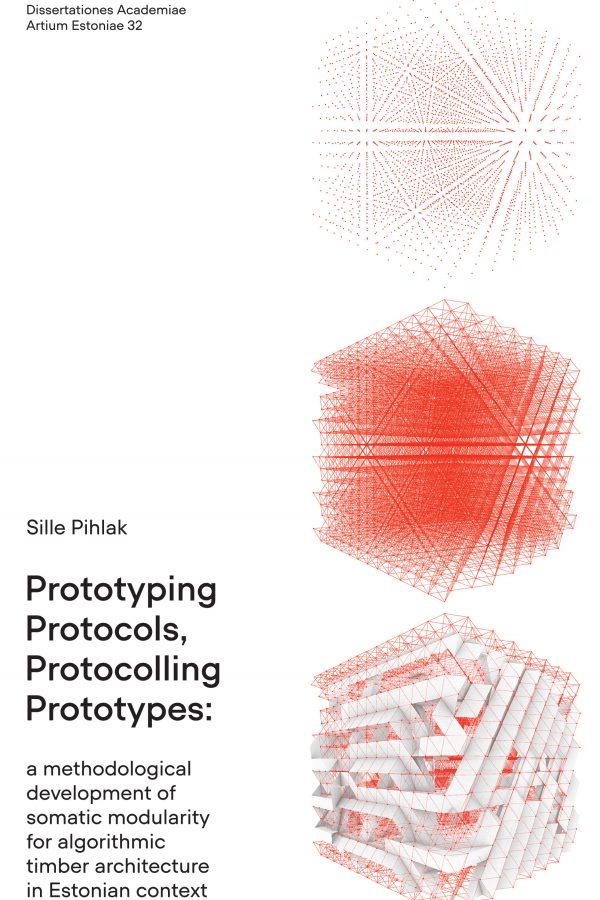PROTOTYPING PROTOCOLS, PROTOCOLLING PROTOTYPES
Sille Pihlak, PhD student of the Estonian Academy of Arts, curriculum of Architecture and Urban Planning, defended her thesis “Prototyping Protocols, Protocolling Prototypes: A Methodological Development of Somatic Modularity for Algorithmic Timber Architecture in Estonian Context” („Prototüüpides protokolle, protokollides prototüüpe: Somaatilise modulaarsuse metodoloogia kujunemine puitarhitektuuris“) on the 21st of December 2020.
This practice-based thesis posits the methodology of somatic modularity as a tool to manage complex, multilayered and highly collaborative workflow processes associated with algorithmic timber architecture. Based on computational modularity and variable resolutions, this methodology is systematized and articulated through the dynamic relationship between the detail and the whole, intending to implement that throughout the design process, including its output. The key objective of the proposed methodology is to identify design “protocols” (a set of design parameters) according to different levels of tectonic complexity introduced in the process of the “prototype” (the preliminary version ) development. The scope of resulting workflow models and their potential to adequately support new algorithmic design approaches is analysed specifically in Estonian context.
Sille Pihlak: “For nearly 90 years, the Estonian construction industry has been neither particularly sustainable nor automated. However, our recent work in the architectural practice PART indicates the possibility of positioning renewable materials again at the heart of the large-scale building economy with digital collaborative workflow between architects, engineers and fabricators. My dissertation addresses the question of how to robustly embed architects’ design intentions in the entire production chain of architecture from design to fabrication, combining bottom-up and top-down design workflows, which will allow more sustainable and design-led contemporary timber architecture to emerge.
I argue for a specific algorithmic workflow, with a central, agile, common platform that has proven to be an advantageous solution in pavilion scale construction, with design implications both in tectonics and for the way we work together. My dissertation maps the development of architectural practice PART, which collaborates closely with Estonian timber house manufacturers, and whose design research has developed from bespoke (2015-2017) and standardized design systems (2017-2018) towards methods of somatic modularity (a variable modular system) since 2018. In each of these periods of development I identify the negotiation between automated design protocols and tangible prototypes and show their potential for contributing to a more articulated, collaborative and material-driven architecture.
I conclude that the systematization of digital design techniques also responds to the changing position of the creative practitioner in relation to algorithmic workflow, and that the application of somatic modularity as a design methodology provides for a strategy to better facilitate design ideas in the rapidly-automating construction industry.”
Juhendajad / Supervisors: Dr Roland Snooks (RMIT University), Dr Jüri Kermik (Estonian Academy of Arts)
Eelretsensendid / External reviewers: Prof Michael U. Hensel (Vienna University of Technology), Dr Jan van Schaik (RMIT University)
Oponendid / Opponents: Prof Michael U. Hensel, Dr Jan van Schaik
Keeletoimetajad / Copy editors: Justin Ions, Taavi Hallimäe
Korrektuur / Proofreading: Justin Ions, Aili Künstler, Tiina Hallik
Kujundus / Design: Robi Jõeleht
Küljendus / Layout: Kadi Pajupuu
Dissertationes Academiae Artium Estoniae 32
245 p, in English with Estonian summary
Eesti Kunstiakadeemia, 2020
ISBN 978-9916-619-06-3 (print)
ISBN 978-9916-619-07-0 (pdf)
ISSN 1736-2261
